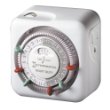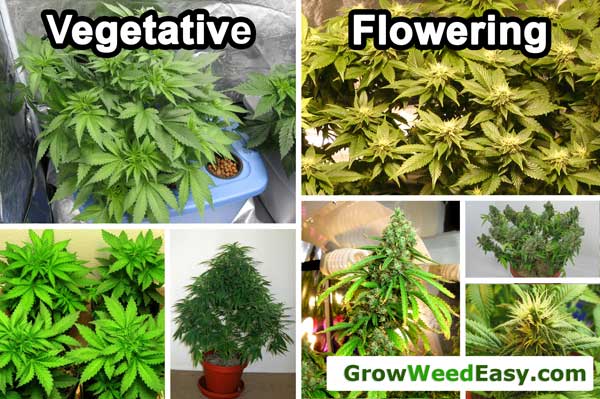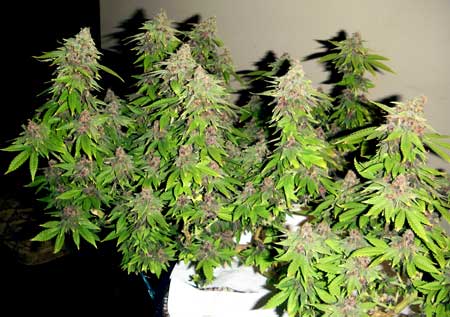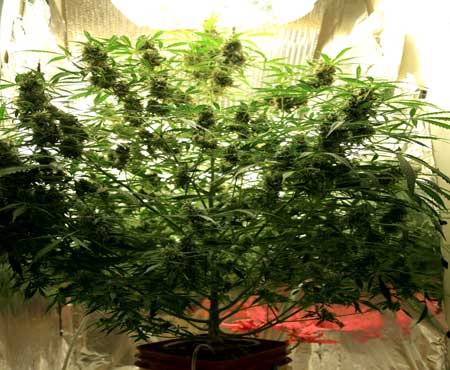When looking at cannabis seed options online, there are "photoperiod" and "auto-flowering" marijuana strains available.
What do these terms mean?
Today, EasilyUsed breaks it down for you…
The Basics of Photoperiod vs Autoflowering Marijuana Strains
by EasilyUsed
Photoperiod Cannabis Strains
Will vegetate essentially indefinitely on anything between an 18/6 and 24/0 light cycle.
Can be cloned, one seed = unlimited plants.
Will flower once put into a 12/12 light cycle.
Usually will take longer to produce a usable yield (average 4 months).
Can produce a larger plant and therefore higher yield.
Will often produce a more potent bud (though that's changing now that auto-flowering genetics are becoming more refined).
Can take more abuse due to unlimited vegetation period.
Responds well to topping and super-cropping in the vegetative cycle.
Learn more about photoperiod strains
Autoflowering Cannabis Strains
Will vegetate for a limited amount of time before automatically going into flowering mode (each strain's vegetative time will be different).
Cannot be cloned (in the traditional sense), one seed = one plant.
Will flower automatically, regardless of light cycle.
Usually will produce usable yield sooner (some as soon as 2 months from seed germination, and usually around 3 months from seed).
Will usually produce a smaller plant and therefore limited yield.
Can't take much abuse due to limited growth time.
May not respond well to topping and super-cropping. (Learn more: Can you "top" auto-flowering strains?)
Both Photoperiod and Autoflowering:
It its natural state, cannabis is an annual plant. This means that these plants grow from new seeds every year, and die at the end of the flowering process, ideally mating, creating and releasing seeds that will grow as the next generation.
Can be stressed and herm (grow both male and female parts) as a result of incorrect light cycle changes.
Seeds can generate male or female plants, unless the seeds are feminized.
Need approximately the same amount of nutrient care.
Can potentially be grown to produce the same size plants with similar yields.
Learn more about autoflowering strains
The in-depth differences…
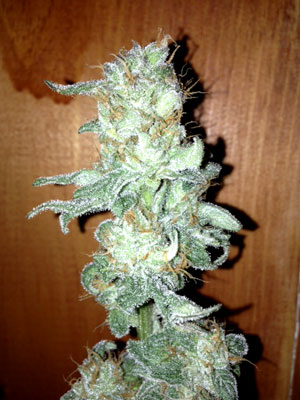
Cannabis sativa and cannabis indica will vegetate almost indefinitely on anything between an 18/6 and 24/0 light schedule, and will only enter full flowering mode when its lighting schedule is limited to 12/12.
If planted outside, growing photoperiod cannabis is only viable "naturally" when planted at the beginning of the summer, naturally entering flowering mode at the end of the summer when the days become shorter.
Outdoor naturally grown cannabis will be ready to harvest in the fall (specifics varying depending on location, as daylight availability depends on your latitude). Outdoor cannabis will not grow naturally any other time of year without supplemental lighting and darkness.
Photoperiod cannabis may be easier to grow indoors for new growers because it can be abused in the vegetative state and have time to recover because it can be vegetated until the grower decides to change the light cycle to flowering.
The flowering process is generally thought to be the most delicate time for the plant; so the utmost care should be given to a plant in its flowering cycle.
Note by Nebula: In some instances, photoperiod strains of cannabis may be easier to grow indoors if you are a new grower because you can give yourself as much time as you need in the vegetative stage. During this stage, cannabis plants are hardy and can bounce back from problems. Even if you make a lot of mistakes, you can still get big yields because you are in control of when the flowering stage begins, unlike with autoflowering strains. Once the flowering cycle is initiated, your plants are more "set" as far as their overall health and structure. Once a cannabis plant starts budding, there is basically a countdown until buds are ready to harvest (this amount of time is mostly based on the strain). Though the plant may have an initial last "stretch" of vegetative growth when the light cycle is first changed over, as the plant approaches harvest towards the end of the flowering stage, almost all growth halts except the development of bigger buds.
Photoperiod cannabis can be cloned indefinitely. Cuts can be taken from photoperiod cannabis to create rooted clones of the plant at any stage, and can be vegetated into large plants before being put into (or back into) the flowering stage.
Quick Key to Light Schedules For Photoperiod (Non-Autoflowering) Strains
This key breaks down some of the terms used in the article below such as "24/0" or 12/12"
Vegetative – Indoor cannabis plants kept on these light schedules will display only vegetative growth
18/6 – 18 Hours Light / 6 Hours Darkness each Day
24/0 – 24 Hours Light / 0 Hours Darkness each Day
Flowering – Indoor cannabis plants on this light schedule will start growing flowers (buds)
12/12 – 12 Hours Light / 12 Hours Darkness each Day
* Most indoor growers use a timer to turn their lights on and off automatically.
Autoflowering Cannabis Strains
Autoflowering cannabis is a human-created crossbreed of cannabis ruderalis and cannabis sativa and/or cannabis indica.
Cannabis ruderalis is a strain of cannabis that naturally will enter its flowering cycle based on a given time since its germination, regardless of light cycle.
This is in contrast to photoperiod cannabis, which will generally only enter flowering when the light cycle has been changed to 12/12.
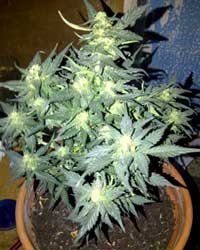
Note by Nebula: The auto-flowering plant pictured to the left is 2 months from seed and has been well-cared for. This plant naturally stayed short and bushy and displays the classical growth pattern of most auto-flowering strains. This plant still has a few weeks before time-to-harvest, and buds will continue to fatten up.
Cannabis ruderalis is also a non-THC potent strain, so when it is cross bred with high-THC-producing sativa or indica, it retains some of the ruderalis properties, and some of the sativa or indica properties, leading to a lesser THC content than a strictly non-ruderalis strain.
Between these two traits, autoflowering strains will theoretically produce not only less bud, but also less potent buds.
Photoperiod strains that are flowered immediately or grown in limited root-space can produce similarly small-sized, quickly flowering plants, but they ought to have a larger THC concentration than their autoflowering counterparts. THC content is still a matter of debate between autoflowering cannabis proponents and detractors.
Autoflowering strains seem more user-friendly for new growers because of the absence of light-cycle decisions. This is a sort of fallacy, as new growers tend also to abuse plants more than seasoned growers.
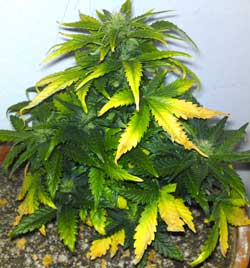
Autoflowering strains will enter flowering (the most delicate stage of growth) regardless of their health.
Photoperiod growers have the choice of entering the flowering period whenever they choose, allowing them to choose this when their plants are healthiest, as well as allowing for more vegetative time for their plants to recover from earlier mistakes.
Autoflowering strains will enter the flowering stage in stressed or unhealthy states automatically, which can limit bud yields.
Autoflowering cannabis cannot be cloned in the traditional sense.
That is, autoflowering cannabis will always retain its 'internal flowering timer.'
If you make a cut of autoflowering cannabis, it can potentially root and create an independent plant, however, this clone will still have the internal clock set to the same automatic flowering clock as its mother.
The clone and mother will still flower at the same amount of time after the original seed they both came from was germinated. Given that autoflowering strains have a very short vegetation cycle, it is debatable whether or not you'd gain a larger yield from making a lot of small flowered clones from one auto or if you let the auto vegetate and flower into one large plant.
Along the same lines, the limited vegetative cycle does not allow for very much drastic growth techniques like topping and super cropping, as the plant doesn't have a lot of time to recover from these before it flowers.
Autoflowering cannabis can be grown outdoors any time of year (assuming it has a reasonable, stable environment in terms of temperature, etc), since it will flower with any light cycle.
Autoflowering cannabis can be grown outdoors in conjunction with photoperiod cannabis to harvest twice in a summer season; once quickly from the autoflowering, and later a second harvest from the photoperiod cannabis.
Autoflowering cannabis is thought to be best grown in anything between a 18/6 and 20/4 light cycle, as it gets a lot of light, but also has time to recover in darkness. It can, however, be grown in 12/12 permanently or 24/0 permanently.
Proven Auto-Flowering Strains
- Auto Northern Lights +
Sturdy strain is easy to grow and a good choice for first-time indoor growers. Performs very well indoors, naturally stays short/bushy, low odor, and potent buds just like the famous Northern Lights strain.
– Best Indoors
– Good for Beginners
– Low Odor
– Potent Buds Like Regular Northern Lights
- Auto Short Rider
This is one of the fastest-finishing auto-flowering strains I've ever seen. It's a great option for outdoor growers with very short summers, or for indoor growers in a hurry, as plants are ready to harvest just 2 months after sprouting from seed. The version by Nirvana produces a good buzz, and despite the very short grow period produces decent yields.
– Ready to Harvest in 2 Months – one of the fastest-finished auto-flowering strains
– Hardy and easy to grow, can even be lightly trained
– Pleasant Buzz
- Auto Blue Mystic
Neutral odor while growing that is reminiscent of hay or flowers, and tropical fruity smell/taste after being harvested and cured. Given the right conditions (happy plants, cooler temps at night as you approach harvest), this strain often shows hints of blue or purple in the buds/flowers. Plants tend to grow a bit bigger than other autos and this strain usually needs a full 3 months of growth before being ready to harvest.
– Indoors or Outdoors
– Neutral odor while growing
– Fruity / tropical smell after buds are cured
– Buds can turn blue or purple
– 3 months before ready to harvest
This plant is much larger than most auto-flowering plants, but shows what can be possible when auto-flowering plants are well taken care of throughout their life.

